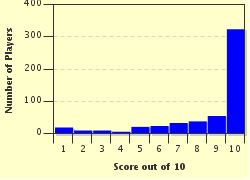Quiz Answer Key and Fun Facts
1. Replace the letters from the alphabet by their ranking order: a=1, b=2, etc. Then multiply the numbers. Which body part has the product 66 ?
To solve this question you start by factoring: 66 = 2 * 3 * 11. (Dividing 66 by 2 gives 33, which is evidently a product of 3*11). Now try and combine these numbers into the corresponding letters: "2" represents B, "3" corresponds with C, "2*3" (=6) can be used for F, "11" is K, "22" (2*11) represents V. See which of these letters can match a four-letter word meaning any part of the body. Don't forget A is the first letter of the alphabet, so any word could contain one or more letters A without altering the product.
2. Replace the letters from the alphabet by their ranking order: a=1, b=2, etc. Then multiply the numbers. Which body part has the product 90 ?
Once again you start by factoring: 90 = 2 * 3 * 3 * 5. Replace the numbers by the corresponding letters (bearing in mind that usually you'll have to multiply some factors to find the correct letter). You can use any of the following letters : A (1), B (2), C (3), E (5), F (2*3=6), I (3*3=9), J (2*5=10), O (3*5=15), R (2*3*3=18).
3. Replace the letters from the alphabet by their ranking order: a=1, b=2, etc. Then multiply the numbers. Which body part has the product 160 ?
This is the last question I'll set you on the right track. Start factoring: 160/2=80, 80/2=40, 40/2=20, 20/2=10, 10/2=5. The factors of 160 are thus 2*2*2*2*2*5.
Corresponding letters can be A (1), B (2), D (2*2=4), E (5), H (2*2*2=8), J (2*5=10), P (2*2*2*2=16), T (2*2*5=20). All answers have at least one vowel, so you'll need at least an A and/or an E.
4. Replace the letters from the alphabet by their ranking order: a=1, b=2, etc. Then multiply the numbers. Which body part has the product 234 ?
Think of the tips and tricks mentioned in previous questions. One extra remark: some of the larger prime numbers might come in handy. For example, if you find a number 13, it has to represent either M (the thirteenth letter) or Z (the twenty-sixth and final letter of the English alphabet).
5. Replace the letters from the alphabet by their ranking order: a=1, b=2, etc. Then multiply the numbers. Which body part has the product 420 ?
Remember the process we've followed in the previous questions.
6. Replace the letters from the alphabet by their ranking order: a=1, b=2, etc. Then multiply the numbers. Which body part has the product 448 ?
Once again, start factoring. You should try and find first of all the necessary vowel.
7. Replace the letters from the alphabet by their ranking order: a=1, b=2, etc. Then multiply the numbers. Which body part has the product 625 ?
Think of the corresponding factors.
8. Replace the letters from the alphabet by their ranking order: a=1, b=2, etc. Then multiply the numbers. Which body part has the product 1,500 ?
Take your time. The correct answer is something most people have more than two of.
9. Replace the letters from the alphabet by their ranking order: a=1, b=2, etc. Then multiply the numbers. Which body part has the product 1,728?
Divide 1,728 in factors and try and find first of all the vowel you'll need.
10. Replace the letters from the alphabet by their ranking order: a=1, b=2, etc. Then multiply the numbers. Which body part has the product 26,334?
Before you start throwing all sorts of paper refuse to me, take a deep breath and try this out. It's not as impossible as it seems. Remember: everything starts with dividing the product in its factors. A prime number such as 19 can come in very handy, for it can represent only one letter.
Source: Author
JanIQ
This quiz was reviewed by FunTrivia editor
crisw before going online.
Any errors found in FunTrivia content are routinely corrected through our feedback system.

